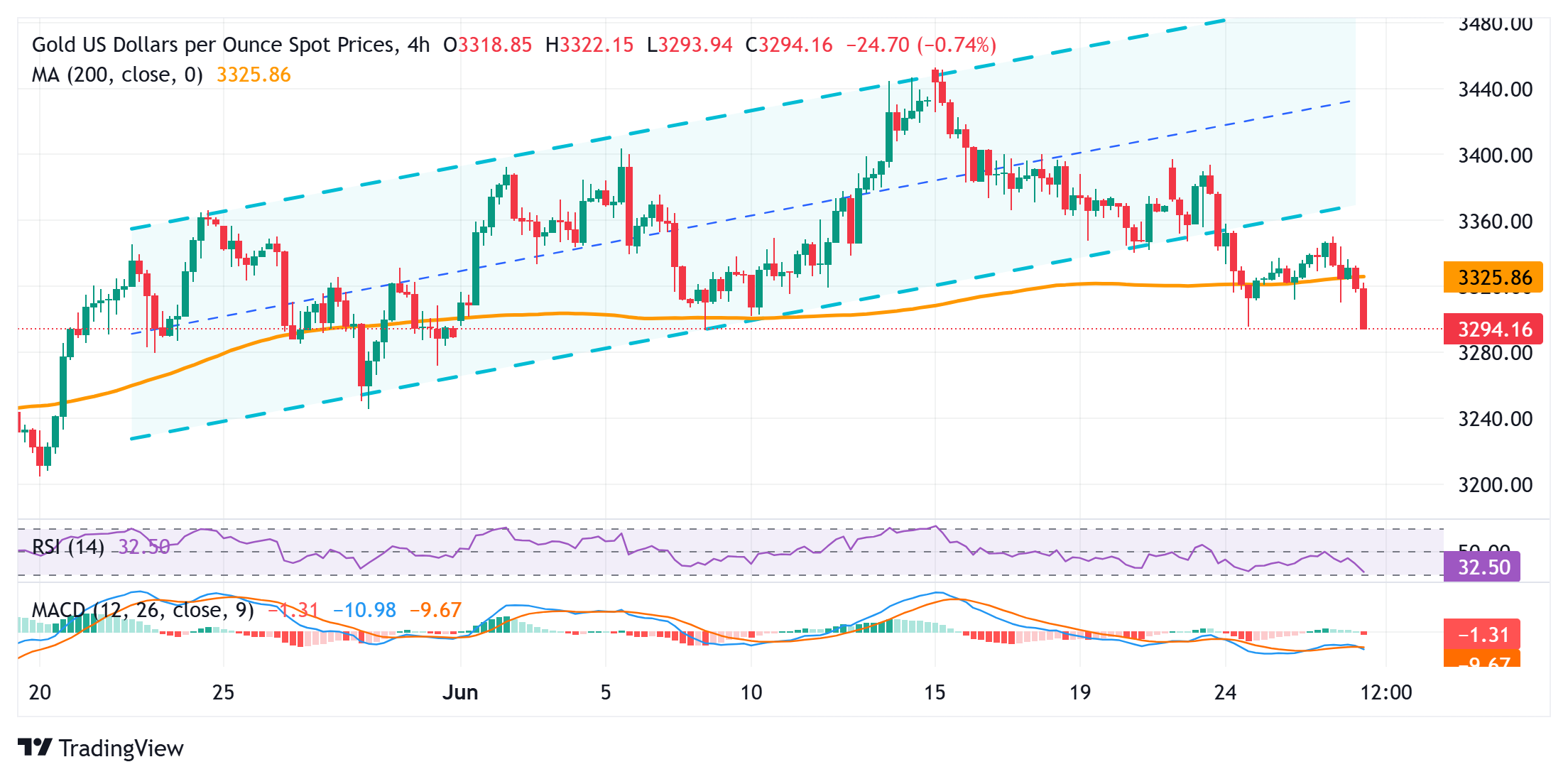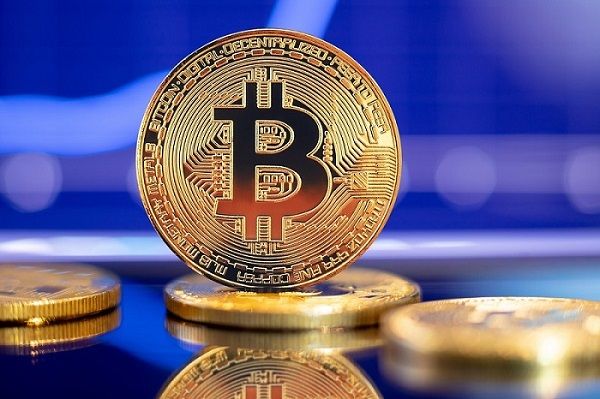Gold price declines to fresh two-week low, further below $3,300 ahead of US PCE data

- Gold price weakens below $3,300 as a positive risk tone undermines safe-haven demand.
- Fed rate cut bets and a bearish USD do little to impress the XAU/USD bulls or lend support.
- Traders now look to the release of the US PCE Price Index for a fresh directional impetus.
Gold price (XAU/USD) attracts fresh sellers following the previous day's directionless price move and slides back below the $3,300 mark during the Asian session on Friday. The commodity approaches a two-week low touched on Tuesday as traders keenly await the release of the US Personal Consumption Expenditure (PCE) Price Index for cues about the Federal Reserve's (Fed) policy outlook. This, in turn, will play a key role in influencing the near-term US Dollar (USD) price dynamics and provide some meaningful impetus to the non-yielding yellow metal.
Heading into the key data risk, the optimism over the Israel-Iran ceasefire and the upbeat market mood seem to drive flows away from the safe-haven Gold price. However, concerns over the Federal Reserve's (Fed) independence and the prevailing bearish sentiment surrounding the US Dollar (USD) could limit losses for the XAU/USD pair. Data released on Thursday showed that the US economy contracted more than previously estimated in the first quarter. This, along with Fed rate cut bets, keeps the USD depressed near a multi-year low and could support the bullion.
Daily Digest Market Movers: Gold price bulls seem reluctant despite weaker USD
- The Commerce Department's third and final estimate released on Thursday showed that the US economy contracted more than previously estimated at the start of 2025 on the back of muted consumer spending and tariff-related disruptions. In fact, the US Gross Domestic Product (GDP) fell at an annualized rate of 0.5% during the January-March period, a steeper decline than the 0.2% reported in the second estimate.
- A separate report published by the US Labor Department showed that the number of Americans filing unemployment benefits for the first time dropped by 10,000 to a seasonally adjusted 236,000 for the week ended June 21. However, Continuing Claims rose by 37,000 to 1.974 million for the week ending June 14. That marked the highest level since November 2021 and suggested a sluggish hiring environment.
- The data fueled speculations that the US Unemployment Rate might tick up to at least 4.3% in June from 4.2% in May. This could force the Federal Reserve to resume its rate-cutting cycle in July and lower borrowing costs further by the end of this year. The outlook drags the US Dollar to its lowest level since March 2022 and might continue to lend some support to the non-yielding Gold price.
- Investors now await the release of the US Personal Consumption Expenditure (PCE) Price Index data, due later this Friday, for further cues about the Fed's rate-cut path. Consensus estimates point to a 0.1% monthly increase in the core PCE Price Index and a 2.6% annual rise in May. A surprisingly stronger print would validate Fed Chair Jerome Powell's wait-and-see approach to rate cuts and boost the USD.
- In fact, Powell reiterated this week that the Fed is well-positioned to wait to cut interest rates until they have a better handle on the impact of steep tariffs on consumer prices. The comments prompted fresh criticism from US President Donald Trump, who has been calling for lower interest rates. Moreover, reports suggest that Trump was considering naming Powell's successor by September or October.
- The development fuels concerns about the potential erosion of the Fed's independence, which should limit any immediate USD positive reaction to the crucial inflation data. This, in turn, suggests that the path of least resistance for the XAU/USD pair is to the upside and any further slide might still be seen as a buying opportunity.
Gold price could accelerate drop below a short-term ascending channel

From a technical perspective, an intraday slide below the 200-period Simple Moving Average (SMA) on the 4-hour chart could be seen as a fresh trigger for the XAU/USD bears against the backdrop of this week's breakdown through a short-term ascending channel. Given that oscillators on the daily chart have just started gaining negative traction, the Gold price might then accelerate the fall towards the $3,245 region before eventually dropping to the $3,210-$3,200 horizontal support and the $3,175 area.
On the flip side, the $3,324-3,325 area now seems to act as an immediate hurdle ahead of the overnight swing high, around the $3,350 region. This is followed by the trend-channel support breakpoint, around the $3,368-3,370 region, which should cap any further gains for the Gold price. A sustained strength beyond the latter, however, could allow the XAU/USD pair to reclaim the $3,400 mark. Some follow-through buying would negate the negative outlook and shift the bias in favor of bulls.
Gold FAQs
Why do people invest in Gold?
Gold has played a key role in human’s history as it has been widely used as a store of value and medium of exchange. Currently, apart from its shine and usage for jewelry, the precious metal is widely seen as a safe-haven asset, meaning that it is considered a good investment during turbulent times. Gold is also widely seen as a hedge against inflation and against depreciating currencies as it doesn’t rely on any specific issuer or government.
Who buys the most Gold?
Central banks are the biggest Gold holders. In their aim to support their currencies in turbulent times, central banks tend to diversify their reserves and buy Gold to improve the perceived strength of the economy and the currency. High Gold reserves can be a source of trust for a country’s solvency. Central banks added 1,136 tonnes of Gold worth around $70 billion to their reserves in 2022, according to data from the World Gold Council. This is the highest yearly purchase since records began. Central banks from emerging economies such as China, India and Turkey are quickly increasing their Gold reserves.
How is Gold correlated with other assets?
Gold has an inverse correlation with the US Dollar and US Treasuries, which are both major reserve and safe-haven assets. When the Dollar depreciates, Gold tends to rise, enabling investors and central banks to diversify their assets in turbulent times. Gold is also inversely correlated with risk assets. A rally in the stock market tends to weaken Gold price, while sell-offs in riskier markets tend to favor the precious metal.
What does the price of Gold depend on?
The price can move due to a wide range of factors. Geopolitical instability or fears of a deep recession can quickly make Gold price escalate due to its safe-haven status. As a yield-less asset, Gold tends to rise with lower interest rates, while higher cost of money usually weighs down on the yellow metal. Still, most moves depend on how the US Dollar (USD) behaves as the asset is priced in dollars (XAU/USD). A strong Dollar tends to keep the price of Gold controlled, whereas a weaker Dollar is likely to push Gold prices up.







